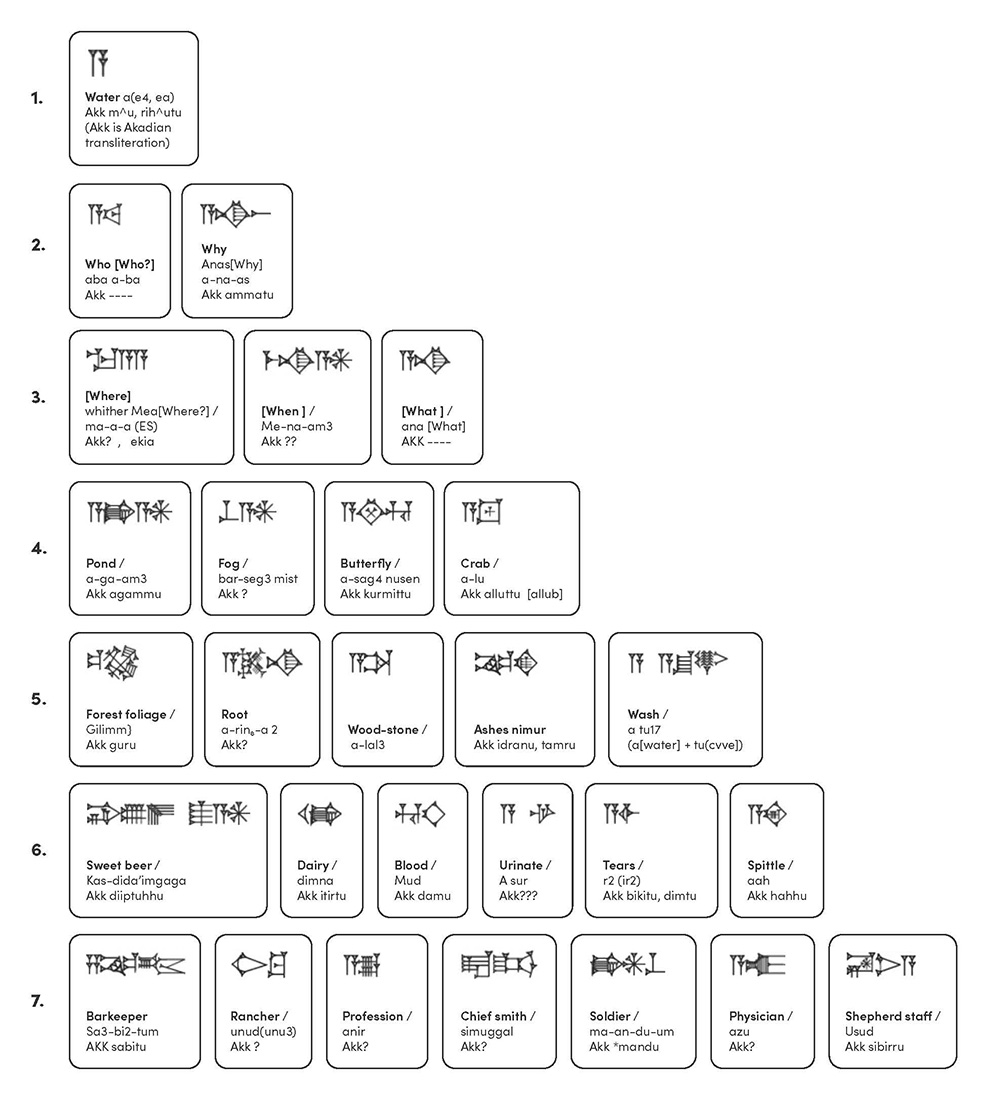
Molecular impressions of water as cuneiform cascade*
This cascade is made up of cuneiform characters that include the character for water, drawn from the website of the Pennsylvania Sumerian Dictionary Project.
Sumerian is one of the world’s oldest written languages, dating back to 3000 BCE. It was spoken in ancient Mesopotamia, in the part of West Asia that is now Iraq and its neighbors. The most familiar literary writings in Sumarian are the Epic of Gilgamesh, Hammurabi Stelae, and the Bihistun mountain inscription.

I have long regarded this ancestral sign of water as the most elegant depiction of H2O’s colligative features: the left wedge with its long tail as the lone pair of electrons, the upper right wedge as the proton and lower right wedge with its shorter tail as the hydroxyl anion.
The next six tiers in my visual cascade somewhat reflect a chaotic cascade of thoughts that comprise this molecular impression of water.
Tiers two and three include this sign in the interrogative questions that are the basis of the science of biological chemistry and other sciences.
Tier four is habitats of germs.
Tier five explores vascular plant processes of extracting minerals from soils and is intended as a simile to elaborate biomorphic images at the Research Collaboratory for Structural Bioinformatics Protein Data Bank, or RCSB PDB.
Tier six depicts various biological fluids.
Tier seven shows the beginnings of a more personable chronology into biomorphic chemistry’s natural history and whether this sign for water may have morphed into Poseidon’s trident or also perhaps the question mark(?). Creation of the question mark has been credited to Alcuin of York, an eighth-century scholar.
*“But we can trace the formation of many words further back than that of species, for we can perceive how they actually arose from the imitation of various sounds.”
— Charles Darwin, “Descent of Man”

Read more
Read more articles and essays about our ASBMB Molecule of the year.
Water, you say? Sephra Rampersad recalls a great scientist asking, what is the one critical component that could make or break your experiment in any lab?
Water takes center stage Danielle Guarracino remembers the role water played at two moments in her life, one doing scary experiments and one facing a health scare.
What I’ve learned about water, aging and protein quality control Alice Liu thought an increase in heat shock protein chaperones would prevent misfolding in Huntington’s disease proteins. The results surprised her, and water was the key.
The subtle strength of hydrogen bonds Indu Sridharan remembers how water complicated her atomic force microscopy imaging studies of collagen.
The teaching power of water “I questioned whether children would be very interested in this exercise; there wasn’t much to it.” At an outreach event, Jessica Desamero learns that three cups of water can convey complex science.
Water rescues the enzyme “Sometimes you must bend the rules to get what you want.” In the case of using water in the purification of calpain-2, Dorothy Croall writes, it was worth the risk.
There are worse things in the water than E. coli E. coli levels determined whether Olympic swimmers could dive into the Seine this past summer. But are these bacteria the best proxy for water contamination? Andrea Luis investigates.
Virtual issue celebrates water in ASBMB journals Check out a dozen gold open-access articles covering exciting research about the society’s 2024 Molecule of the Year.
Enjoy reading ASBMB Today?
Become a member to receive the print edition four times a year and the digital edition monthly.
Learn moreGet the latest from ASBMB Today
Enter your email address, and we’ll send you a weekly email with recent articles, interviews and more.
Latest in Opinions
Opinions highlights or most popular articles

Sketching, scribbling and scicomm
Graduate student Ari Paiz describes how her love of science and art blend to make her an effective science communicator.

Embrace your neurodivergence and flourish in college
This guide offers practical advice on setting yourself up for success — learn how to leverage campus resources, work with professors and embrace your strengths.

Survival tools for a neurodivergent brain in academia
Working in academia is hard, and being neurodivergent makes it harder. Here are a few tools that may help, from a Ph.D. student with ADHD.

Hidden strengths of an autistic scientist
Navigating the world of scientific research as an autistic scientist comes with unique challenges —microaggressions, communication hurdles and the constant pressure to conform to social norms, postbaccalaureate student Taylor Stolberg writes.

Black excellence in biotech: Shaping the future of an industry
This Black History Month, we highlight the impact of DEI initiatives, trailblazing scientists and industry leaders working to create a more inclusive and scientific community. Discover how you can be part of the movement.

Attend ASBMB’s career and education fair
Attending the ASBMB career and education fair is a great way to explore new opportunities, make valuable connections and gain insights into potential career paths.

